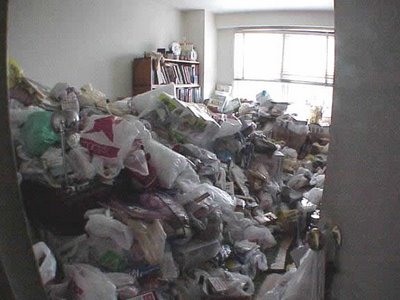Couple Suffering From Hoarding Disease Found Buried Alive In Home

An elderly couple on Chicago’s South side has been hospitalized in serious condition after they were buried alive in their own home. A neighbor called the police after not seeing the pair, both in their 70s, for a three weeks. Chicago Fire Department paramedics heard their cries for help, and donned hazardous materials suits before pulling the couple from their home. They are currently at Jackson Park hospital, expected to make a full recovery.
The unidentified couple’s house and yard were stacked with cast-off items, including three broken refrigerators with the doors still attached. A detached garage was piled to the ceiling with jumbled junk, damaged electrical cords and worn-out clothing.
According to Consumer Reports, hoarding is a compulsive behavior akin to OCD or repetitive hand washing. It has little in common with poor housekeeping, or with garden-variety messiness. In fact, many hoarders are neat and organized earlier in their lives. For unknown reasons, most hoarders are past middle age and if left untreated, the condition often grows worse.
How can you know if an elderly parent’s hoarding has crossed the line? Like any other condition, when hoarding interferes with work, or family relationships, it is a mental health issue. In addition, safety is a concern with hoarding. If the home has become a fire hazard or is infested with vermin, that is an indication of a serious problem.
There are a variety of reasons why an individual might begin to hoard objects, according to David F. Tolin, Ph.D. Often, they cling to items that have little intrinsic value or appear worthless to others, such as broken toasters and ancient unread magazine. The items almost always have emotional resonance to the hoarder. Sometimes unread magazines, newspapers or other items represent a future project. Symbolically, by discarding the items, the patient is discarding their dreams for the future.
Other hoarding behaviors may be rooted in fear of illness or poverty, an inability to face painful issues or a desire to cling to happy memories.
Collecting pets in large numbers is a type of hoarding – especially if an older person cannot care for all of the pets. Often, they equate pets with love, and are trying to hoard the secure, loving feelings that they associate with earlier pets.
Hoarding is a defense mechanism. Don’t be tempted to simply clear out all the junk. This often precipitates an emotional crisis for the hoarder, who is suddenly deprived of his or her comfort zone. It is far better to urge the person to get help. In most cases, a hoarder cannot be forced to accept treatment unless there is an immediate hazard in the home. Drugs are ineffective in treating hoarding. Instead, patients benefit from cognitive-behavioral therapy.
By Joni Holderman, [email protected], contributing reporter for Mental Health News.